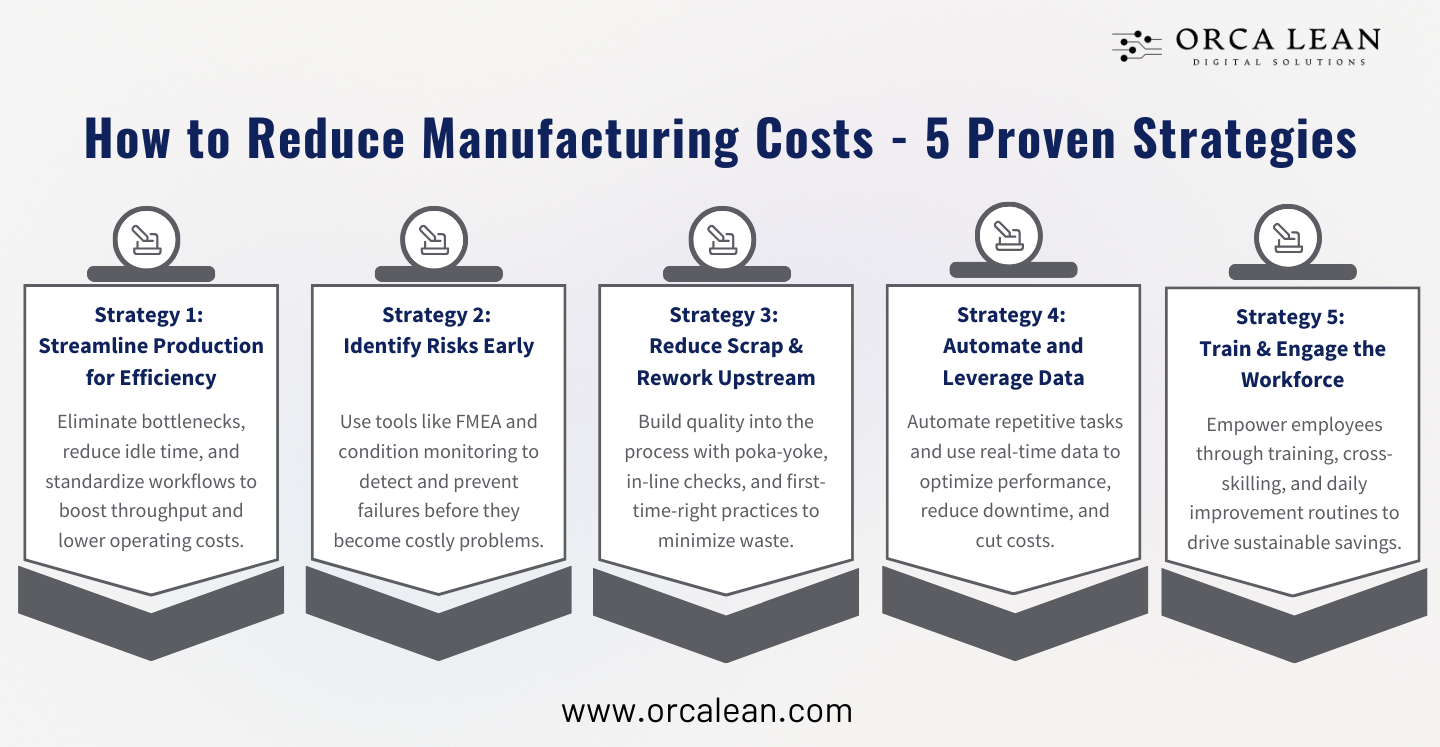
Executive & Strategy
FactoryKPI Executive
KPI Dashboard with Multi-plant analytics and comparisons
Problem Solving
SolvoNext-PDCA
A Smarter Problem Solving and Project Management Software based on deming and Toyota's PDCA - Plan, Do, Check, Act Method.
Qualitygram
A Unique Mobile and Web Software that helps Manage and Solve Problems Faster with Improved Team Communication.
SolvoNext-NCR CAPA
Digitize your NCR & CAPA process and Reduce Cost of Poor Quality (COPQ).

How to Reduce Manufacturing Costs: Proven Strategies to Lower Costs Without Sacrificing Value
March 25, 2025
Manufacturers today are under relentless pressure to do more with less. Whether it’s inflation squeezing margins, customers demanding shorter lead times, or global competition intensifying, cutting costs has become a survival skill.
But here’s the catch: indiscriminate cost-cutting—like slashing headcount, buying cheaper materials, or deferring maintenance—often causes more harm than good. Real savings come from making operations leaner, smarter, and more resilient.
In this blog, we’ll break down five strategic ways manufacturers can reduce costs without sacrificing product quality, customer value, or team morale. These aren't surface-level suggestions—they’re proven levers that drive both efficiency and excellence.
Why Traditional Cost-Cutting Fails
When cost pressure rises, many companies instinctively reach for the axe: lay off workers, freeze training budgets, or delay critical upgrades. At first glance, it works. The balance sheet looks better—temporarily.
But then the cracks appear:
- Quality dips, leading to customer complaints and lost contracts.
- Employee morale sinks, triggering high turnover and tribal knowledge loss.
- Machines fail unexpectedly, causing expensive downtime and late deliveries.
Why? Because reactive cost-cutting treats symptoms, not root causes. It's tactical, not strategic.
True cost reduction comes from enhancing the system. It requires understanding where value is created—and where waste hides. The five strategies below focus exactly on that: reducing cost at the source without reducing capability.

Strategy 1: Streamlining Production Processes and Improving Efficiency
Every production line hides opportunities. Long changeovers. Idle time between processes. Excessive material handling. These inefficiencies quietly drain profit.
Streamlining production means re-engineering the process so that it flows with minimal waste. Tools like Value Stream Mapping (VSM) help you visualize where time, money, and energy are lost between steps. From there, targeted interventions can improve:
- Cycle time: reduce by standardizing work and removing bottlenecks.
- Machine uptime: increase via quick changeover (SMED) and better scheduling.
- Throughput: optimize takt time to match customer demand.
Confused between the Takt Time and Cycle Time, read our detailed blog to understand the difference.
Example: A Tier 2 automotive supplier used VSM and found that their welding line operators spent 28% of their shift walking between workstations. After redesigning the layout, they cut total production time by 14%, saving both labor and overhead without touching product quality.
The key here is precision. You're not just removing steps—you're removing non-value-adding ones.
Strategy 2: Identifying Risks Before They Manifest Into Costly Problems
Think of every unplanned breakdown, product recall, or safety incident as a missed opportunity to see it coming.
Proactive risk management is about recognizing weak signals before they become loud, expensive failures. It combines:
- FMEA (Failure Modes and Effects Analysis) to assess potential failures by severity, occurrence, and detectability.
- Condition-based monitoring to catch machine degradation early.
- Root Cause Analysis (RCA) to ensure corrective actions stick.
The cost of reacting to problems downstream is 10x–100x higher than preventing them upstream.
Example: A food manufacturer adopted vibration analysis on key mixing equipment. They spotted a misaligned shaft days before it would have caused catastrophic failure—saving $72,000 in repairs and avoiding an unplanned 3-day shutdown.
By shifting from firefighting to foresight, manufacturers can dramatically reduce cost leakages that are often invisible until it’s too late.
Strategy 3: Reducing Scrap and Rework Upstream
Scrap and rework aren’t just material losses—they're compounded waste: time, labor, energy, and customer trust.
Yet many plants try to address these issues after the defect has occurred. The smarter play? Build quality into the process from the start:
- Poka-yoke (error-proofing): prevent mistakes before they happen.
- First-time-right metrics: focus on process capability, not just output volume.
- In-line quality checks: catch deviations early instead of relying on end-of-line inspection.

Example: An electronics assembly line used thermal cameras and AI-based visual inspection to detect improper soldering in real-time. Defect rates dropped by 35% within two months, cutting rework costs by over $100K annually.
What makes this cost reduction powerful is its compounding effect: less scrap → lower material spend → faster throughput → happier customers.
Strategy 4: Automating Key Processes and Using Data-Driven Insights
Automation isn’t about replacing humans—it’s about freeing them to focus on higher-value tasks while machines handle the repeatable, error-prone, or hazardous ones.
Targeted automation of assembly, inspection, and packaging can:
- Improve consistency and reduce variability.
- Cut labor costs tied to non-core activities.
- Operate 24/7 with fewer interruptions.
But automation alone isn’t enough. The real magic comes when paired with data-driven decision making:
- Use IoT sensors to track machine performance in real time.
- Analyze OEE (Overall Equipment Effectiveness) dashboards to pinpoint low-performing assets.
- Leverage historical data to forecast maintenance or optimize energy usage.
Example: A plastics manufacturer installed sensors on 40 injection molding machines. By tracking energy use, downtime, and cycle variations, they uncovered that three machines were operating 20% below optimal efficiency. Adjustments saved $14,000/month—just from smarter data use.
Automation isn’t about buying robots—it’s about removing blind spots.
Strategy 5: Enhancing Workforce Training and Engagement
Ironically, the most overlooked cost lever in manufacturing is human potential.
Well-trained, engaged employees spot inefficiencies, prevent errors, and drive improvements from the ground up. On the flip side, undertrained workers create costly variability, safety issues, and bottlenecks.
Strategies that pay off:
- Cross-training for workforce flexibility and reduced downtime.
- Kaizen events to let operators lead improvement initiatives.
- Tiered daily meetings to align teams on goals, issues, and quick wins.
Example: At a packaging plant, operators were given visual dashboards of key metrics and trained to suggest daily improvements. Within six months, the plant reported a 12% improvement in productivity and a 40% increase in employee-initiated cost-saving ideas.
When your workforce owns the process, they also own the results.
Conclusion
Reducing manufacturing costs isn’t about slashing budgets or squeezing teams—it’s about working smarter across your operations. The five strategies of cost reduction we’ve covered aren’t theoretical—they’re practical, proven, and built for the challenges of modern manufacturing.
But executing them consistently? That’s where most plants struggle.
Solvonext is built to close that gap. From streamlining workflows to reducing scrap and rework, Solvonext digitizes continuous improvement and gives your teams the tools, visibility, and structure they need to drive real savings—without compromising value.
Want to see where your biggest cost-saving opportunities are hiding?
Book a demo of Solvonext and discover how smarter processes lead to leaner, more profitable operations.
Request a Demo Today – Start reducing costs the right way.

Software Solutions for Manufacturing Excellence
Company
Social
Our Contact Info:
Email: contact@orcalean.com
Phone Number: 248 938 0375
Our Offices